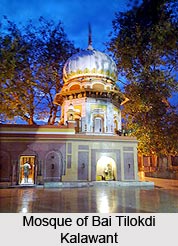 Mosque of Bai Tilokdi Kalawant located in Rajasthan is an ancient building built during the Muslim period. The mosque was built by Bai Tilokdi (Trilok Devi) Kalawant, the daughter of famous musician Mian Tansen in the year 1652 A. D. The shrine built during the Mughal period is situated in the Dargah Bazar. The inscription engraved in the mosque bears the name of the daughter of Mian Tansen. It also states that Abul Fazl had given the name of Tansen`s son as Tantaray Khan. The original name of the son was Bilas. The inscription has been written in Persian language and has been engraved in relief on a marble slab that measures 12 x 14". It is visible over the central mihrab of the mosque and is at a height of 13 feet from the floor. The script of the inscription is nastaliq. According to the inscription Tilokdi was also a musician like her father.
Mosque of Bai Tilokdi Kalawant located in Rajasthan is an ancient building built during the Muslim period. The mosque was built by Bai Tilokdi (Trilok Devi) Kalawant, the daughter of famous musician Mian Tansen in the year 1652 A. D. The shrine built during the Mughal period is situated in the Dargah Bazar. The inscription engraved in the mosque bears the name of the daughter of Mian Tansen. It also states that Abul Fazl had given the name of Tansen`s son as Tantaray Khan. The original name of the son was Bilas. The inscription has been written in Persian language and has been engraved in relief on a marble slab that measures 12 x 14". It is visible over the central mihrab of the mosque and is at a height of 13 feet from the floor. The script of the inscription is nastaliq. According to the inscription Tilokdi was also a musician like her father.
This article is a stub. You can enrich by adding more information to it. Send your Write Up to content@indianetzone.com





















